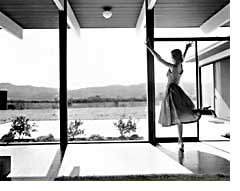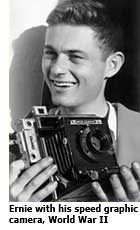Ernie Braun: Photographer Behind the Eichlers - Page 2
As for the shots themselves, Braun liked the use of implied movement. This predisposition to show progressions in his shots evolved from his work during World War II, when he was a U.S. Army combat photographer in Europe. "I'd put two photos together—because you can't photograph bullets flying," he explained. So, he'd take, say, one shot of soldiers running, and the other of their hitting the ground. Another element that was perhaps born in combat was Braun's bias towards using natural lighting as much as possible. "I learned that you couldn't use flash photography over there," commented Braun, recalling the battlefield. "In fact, the first time I tried using a flash bulb at dusk—bam, within seconds, mortar shells came racing in."
By the time Braun started photographing for Eichler Homes in 1954, at the age of 33, he had already honed his craft—first, shooting publicity photos while a student working his way through college at San Diego State; then, in the prewar years, running a photo lab for the Navy involved in the development of sonar and radar; and lastly, as a partner in a photographic studio in Manhattan, New York.

Just as his involvement in photography had become second nature to Braun by the time he found Eichler Homes, his Eichler work routinely would take advantage of lighting changes at different times of the day. If he wanted to emphasize home entertaining, for instance, Braun would stage a cocktail party in the dramatic glow of the evening. But in the daytime, there was a whole other gamut of options. "See how the light is not directly on the people, but reflected," Braun said, pointing to a glossy print of an impressive outdoor lounge scene staged in an Eichler patio. "If you wanted the light streaming in like this, you'd take the photo either fairly early or late in the day—depending on how the house was oriented—because the sun is really harsh when it's shining directly on people.
Sometimes overcast days worked well too, Braun indicated, because they presented less contrast. Since film and paper are unable to record bright contrasts, the haze overhead oftentimes allowed many objects and textures—like the extending structural beams of the house, or the checkered pattern of the picnic blanket—to become better defined.

"Architectural photography is a balancing act," stated Braun, "because the indoor light is so much less than the outdoor light." So, for the interiors of Eichler homes, Braun would bring the shots to life by mixing in the flash of old-fashioned blue bulbs to emphasize particular aspects of the room. However, he would orient the bulbs, which were on stands pointed away from the scene, aimed at a background wall to give an indirect 'bounce' of light. "You can see reflection of light on the coffee pot or in the glasses of this kitchen scene," stated Braun, "because I taped pieces of white sheeting to the wall to reflect the light, so you weren't aware of it."
As for the arrangements of the Knoll and Herman Miller furniture that were carefully placed around model homes, Braun's secret oftentimes was to reposition them to fit the focal length of his lens. "It's very important the way the lines work," he explained, so if Braun found an angle he liked with the camera, he would manipulate everything else to fill the frame. "Ernie had a compositional need that was in front of him in that ground-glass plate in his camera's viewfinder," added Matt Kahn, Eichler Homes' principle designer, who was moved in more ways than one by Ernie's work. Kahn admits to occasionally having made noise over Braun's redesigns, "but I don't want to over-emphasize that," he stated. He pointed out that Braun was trying to make a statement in his photographs that was reflective of the spirit of the room, and not the room itself, and this naturally called for reorienting furniture and other objects.
Joe and son Ned Eichler sought out people who were the best of their trade, according to Kahn, since 1949 a professor of art at Stanford University. "The Eichlers reached consistently for great things, sometimes to a fault," he said, recalling that the two company heads or their staff would naturally have gone to Mecca for everything, if they could. "And Ernie Braun," according to Kahn, "was an architectural photographer who was Mecca."




